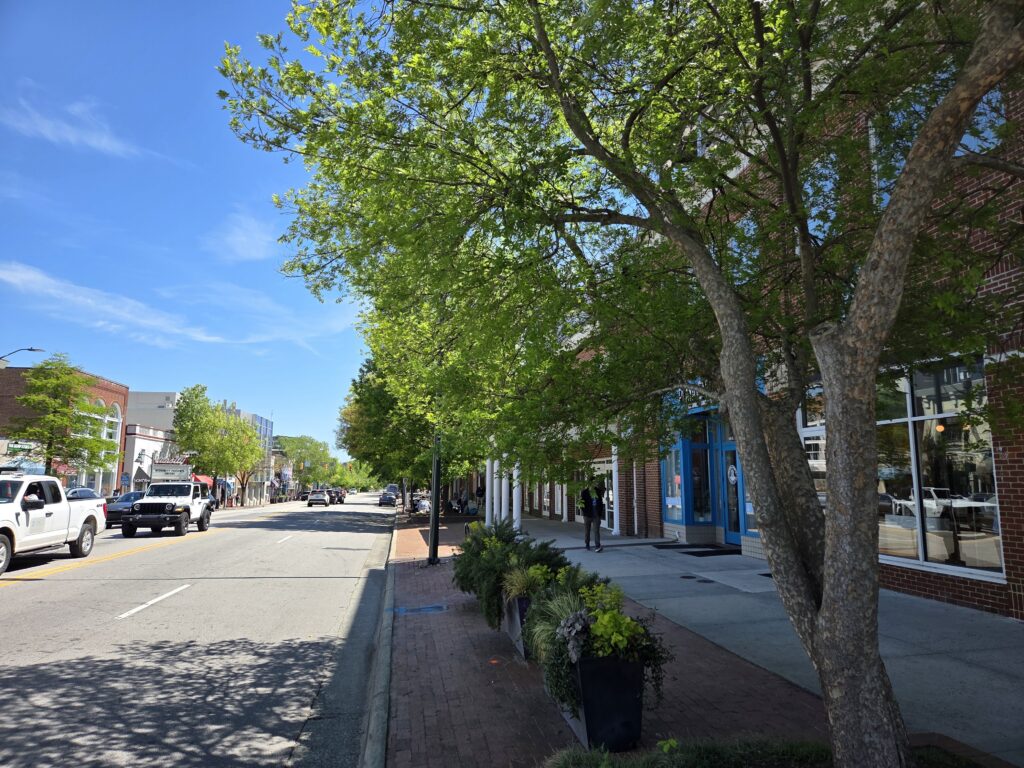
Looking east from South Columbia at East Franklin
This is the second in a series on Downtown trees. The first installment covers the other side of the street.
The 100 block of East Franklin Street—like every other artefact of our moderately sedentary, city-state, world-building, comfort-seeking society—is a flower. Or an iceberg. Or your best friend. A thing that is at once graspable yet changing and slipping around in time and perhaps always letting bits of itself out from betwixt your fingers before you’ve really had a chance to have a good look. The philosopher Timothy Merton uses the term “hyperobject” to reference these things that we understand, generally, but are too large in space and time to fully grasp. Climate change is an example he uses. Perhaps a section of a small-town downtown is a stretch and I should pack this little opening paragraph up into the box I brought it here in and start again. I dunno. That’s a bunch of words and perhaps I’ve said something. We’ll leave it for now.
My point is that these spaces we’ve constructed to surround ourselves and provide for ourselves and sometimes define ourselves are in flux; they change along many time scales. The corner of Franklin and Columbia brings up multiple images in my mind when I take a minute and recollect. As I’m sure it does for any of y’all who’ve been in the neighborhood for more than a minute. They change along spatial scales as well, the structures that define the spaces we inhabit come and go with irregularity, ambiguity, sometimes hilarity. Our inclination to build and destroy and rebuild is everywhere evident in our cities, certainly in our city centers.
Fascinating, right? Where are the trees? Well, exactly my point!
Meet Downtown Chapel Hill’s Street Trees, Part 2
The 100 block’s southside trees
The trees I’m showing you today were not the trees the older cats who I drank with at the Carolina Coffee Shop 30 years ago took a moment to pause under perhaps to steady themselves for the slow amble home. And likely they will not be the trees the newborns of this decade will come to appreciate as they notice the grey above their brows and the more than occasional wild hairs coming out in new places. For now, now is what we have, and these few trees are swell companions as we walk together through our little downtown.
Note: Things change quickly in a Southern summer and the photos accompanying the prose were taken a little bit ago and may not reflect the current situation.
Tree 1: Chinese elm
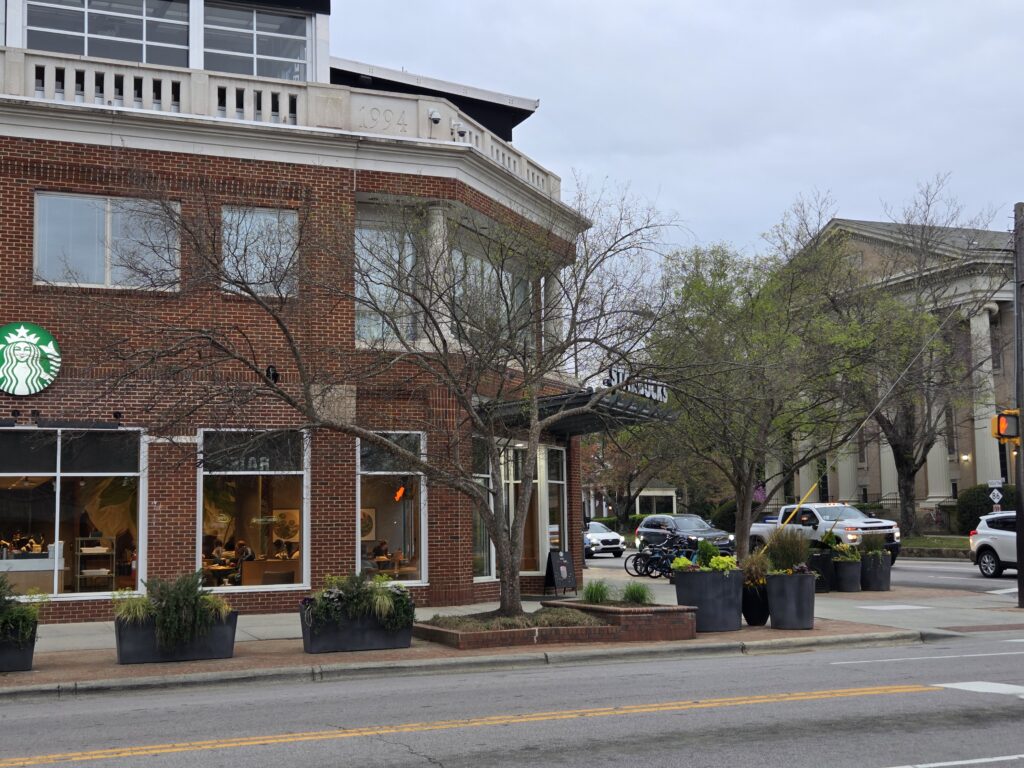
Despite being surrounded by small bricks and concrete sidewalk—and who knows what all under the surface—this Chinese elm (Ulmus parvifolia) is making it work.
The first little tree sits in front of that big-box coffee shop on the corner of E. Franklin and S. Columbia Streets. It’s a Chinese elm (Ulmus parvifolia), previously encountered on the other side of the road in several spots. It’s a proven and capable player, able to handle the vagaries of street tree living. Tough, tidy and relatively attractive.
I should note that this species is making a bit of a nuisance of itself. Weedy is a word I’m hearing. Whispers of invasive tendencies. There is a call for a rethink on continuing to include it in urban streetscape planning. This is important—we should all care about plants that tend to jump around, especially when that jumping leads to widespread spreading and displacement of already established (native) plants. Not to take up too much of your time from the soapbox…but paying attention to nonnative plants in the landscape and observing behaviors over time only increases understanding of a given plant’s ability and willingness to become a “bad actor”. Those of you familiar with stilt grass (Microstegium vimineum) will no doubt appreciate that a bit more diligence a hundred years back could have slowed down, perhaps even eliminated the spread of this plant through our forests. So those of us who watch, watch. And we communicate and if we notice bad behavior, we act. Right now, let’s appreciate the really cool bark texture, the lacy fractal branching structure, the promise of shade in August.
Read about another surprising “nuisance”, the Lenten rose (Helleborus orientalis).
Head east towards the Planetarium and we’ve got three trees in a line, spaced maybe 15 feet apart—I didn’t have a tape on me when I was taking pictures and scouring the planter boxes for acorn fragments—each wanting to be, well, trees when they grow up. These are the pin oak (Quercus palustris), Chinese pistache (Pistacia chinensis) and Northern red oak (Quercus rubra). Trees in general are really great at resource allocation (they share), but when placed too close together, sometimes tangles ensue. We will watch, we will see.

This pin oak (Quercus palustris) leafed out before the Chinese pistache (Pistacia chinensis) and Northern red oak (Quercus rubra) beside it.
Trees 2, 12 & 16: Pin oak
The native pin oak (Quercus palustris) is a workhorse of a tree—egg-shaped and keeping at about 30-40′ across. There are two more: another further down the street, huddled in with the trios that front the University United Methodist Church (#12) and Battle-Vance-Pettigrew Hall (#16). Pin oak is a rather nondescript member of the red oak group that has put on this year’s coat and is ready for anything. Not really my favorite tree; utilitarian, tough as old cheese. Honestly, I do not mind pin oaks, they just underwhelm on the other side of the teeter-totter from the more charismatic members of the genus. Scarlet, black, water, Shumard, live…there’s no shortage of oak diversity in the Piedmont. That said, it’s a long shot for a street tree to fully express itself, so one should perhaps be a bit less judgmental in characterization and suitability (speaking to myself here, don’t mind me, I’ll be done shortly).
Margot asked me to remind you that what some people (including her, growing up) call a pin oak is actually a willow oak (Quercus phellos). And when you look at the leaves, you can see why. They do resemble a pin or a pen—and depending on from whence you and your people hail, those could be pronounced the same.
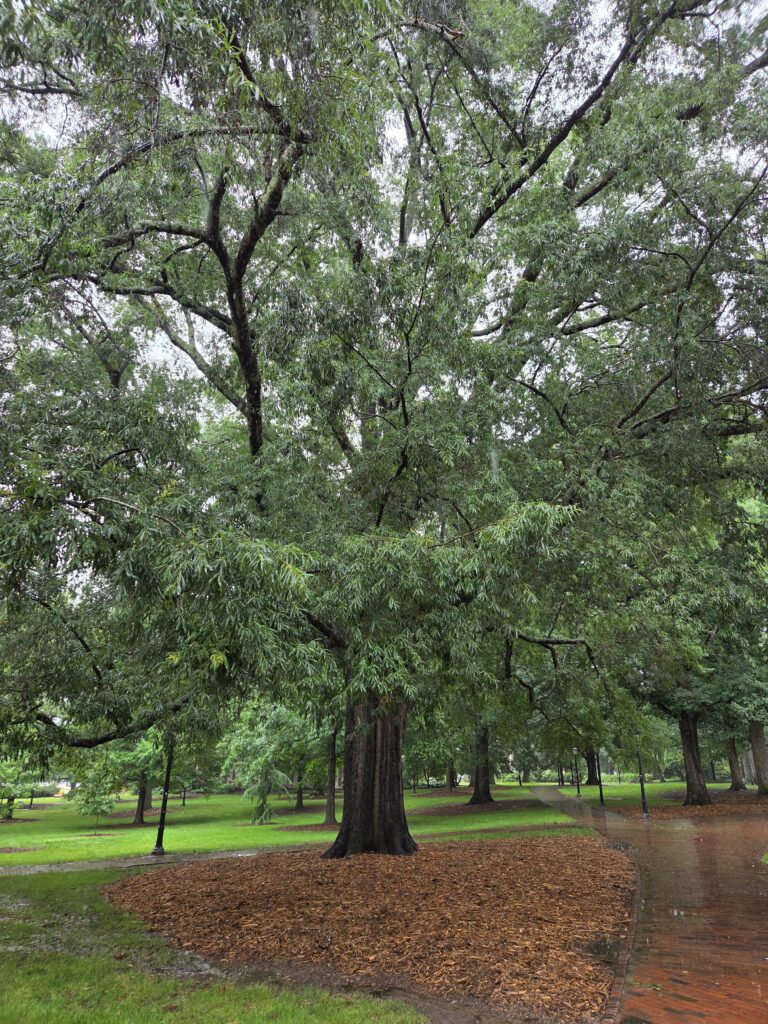
The leaves of the willow oak (Quercus phellos) do look more like pins than the leaves of the pin oak (Quercus palustris).
Trees 3, 6, 7, 9, 13 & 17: Chinese pistache
Next to our pin oak is a lovely Chinese pistache (Pistacia chinensis) in front of Cosmic Cantina. This tree and the oak beside it are going to start a conversation soon as they each reach for their share of canopy space. The pistache likes to open up its canopy as it ages, easily having a 60’ spread at maturity. She’s gangly and unsure at first, but the overall form when full-grown is a lovely sight. I referred to the pistache as “she” you may notice. In this case deliberate as this one is indeed a female tree, having flowered and now starting to fruit. Some trees have male and female flowers on separate individuals.
There are five more: one each in front of Johnny T-Shirt, the UNC Visitor’s Center and Battle-Vance-Pettigrew Halls; and two at University Methodist. Maybe someone got a deal somewhere when it was time to switch out those willow oaks. It’s well-represented on the other side of the street, too. They should provide a nice splash of fall color together when the season gets around to it.
Tree 4: Northern red oak
On the other side of our up-and-coming pistache is a young Northern red oak (Quercus rubra). I’m pretty sure on this one. I was able to find an acorn or two and a cap, not easy this year as the squirrels have been especially good at their foraging. The red oak will also want its own room in this tiny house they’ve all been asked to share. I suspect the middle child (the Chinese pistache) will be the first to leave home.
Tree 5: Ironwood
The fifth tree in our lineup is a bit of a surprise. Ironwood, or musclewood (Carpinus caroliniana), is a southeastern native hardwood with distinctive bark, smooth and sinewy, to repeat the oft-repeated adjectivals. This one will be fun to watch as the overall branching structure is irregular. Not as lacy as the elm. The current storefront being graced by this small tree is the currently unoccupied (sigh): 122 E. Franklin.
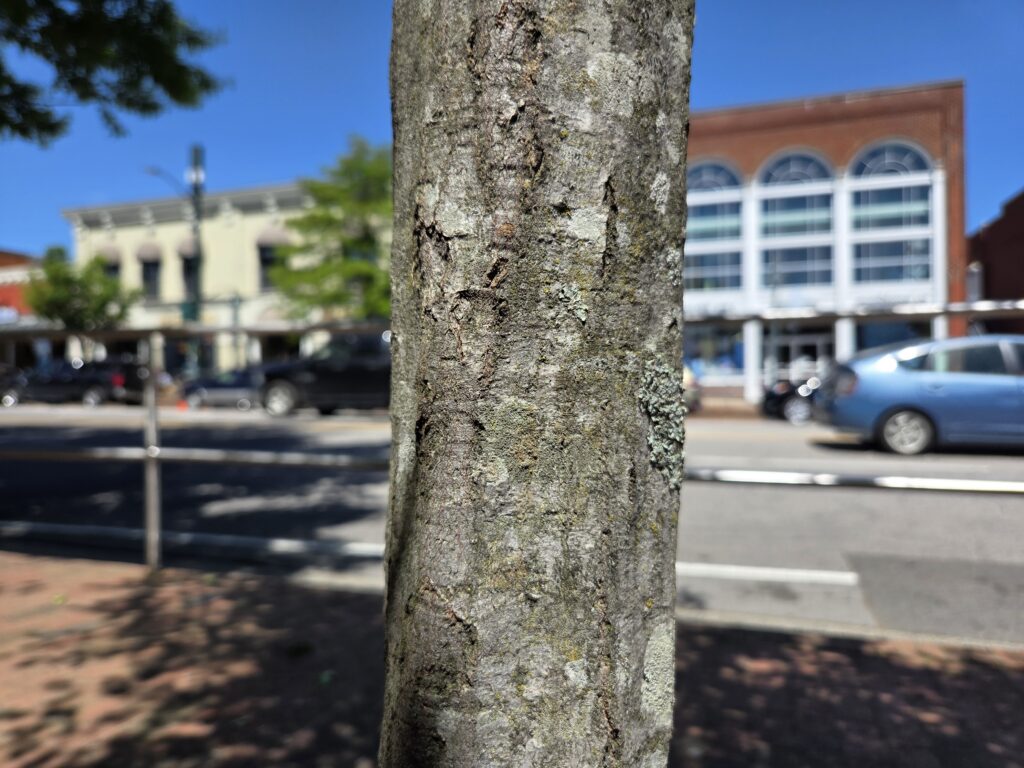
This Pistacia chinensis greets passersby on Franklin Street.
The sixth and seventh trees are our old friend, the Chinese pistache, in front of the UNC Visitor Center.

Note the sinewy lines that give Ironwood (Carpinus caroliniana) its nickname: musclewood.
Tree 8: American elm
A quick step across Porthole Alley and we’re in front of Carolina Coffee Shop (the oldest continually operating restaurant in North Carolina…how about that?). Tree #8 grows just beside the crosswalk, an American elm (Ulmus americana). This youngish specimen is about as tall as the buildings it will one day shade. That’s assuming the buildings are still standing there in another hundred years. This stately native tree will develop an arching, fountain-like structure, a strong central leader opening into a spray of smaller branches, each giving rise to their own bifurcating assemblages of twiggery. The mature elm may reach 80’ or more in height, with a comparable canopy spread.
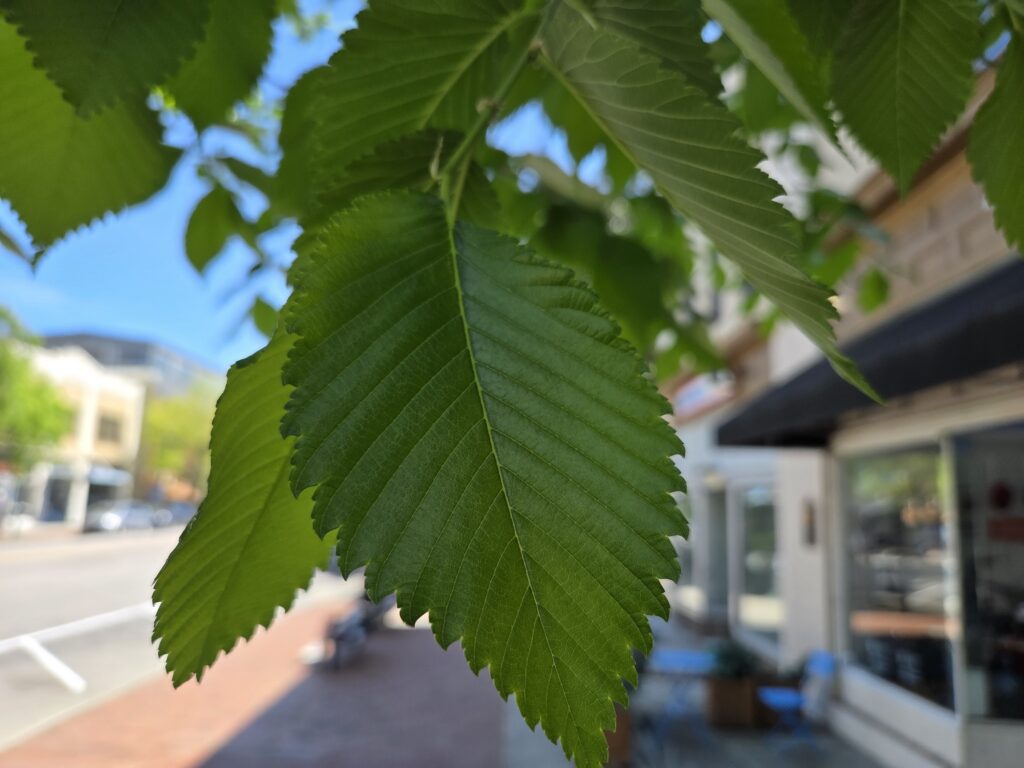
This American elm (Ulmus americana) marks the entrance to Porthole Alley.
The remainder of the block is almost wholly occupied by University United Methodist Church. This building was dedicated in 1935, serving as the current home for a church whose Chapel Hill roots go back to 1840, when it was housed in the building on the NE corner of Rosemary and Henderson Streets. The steeple is 210’ tall, certainly one of the tallest objects in our little village and guaranteed taller than any of the trees that line the streetscape along the north side of the building. We’ve noted the pistache trees (#9 & #13 for those keeping track), next in line are a trio of oaks, all fine additions to the collection.

A trio of oaks—white oak (Quercus alba), laurel oak (Quercus laurifolia) and pin oak (Quercus palustris)—lines the sidewalk in front of University United Methodist Church.
Trees 10 & 15: Laurel oak
The laurel oak (Quercus laurifolia) closely resembles the more common willow oak, notably different in the overall leaf shape.
Trees 11 & 14: White oak
This tree is a personal favorite of mine, the white oak (Quercus alba). There are so many excellent specimens of this tree on campus, especially in McCorkle Place. Nice to see them downtown. I’m partial to all trees, mind you, at least all the ones that play nicely with others. But a well-tended and well-formed (a straight-line causal relationship, BTW) white oak is a wonderful neighbor and friend. Host for hundreds of distinct species of life, magnificent engine, food, shelter, symphony of whispers over an autumn wind, a whole crayon box of textures, variety in form viewed through a range of lenses, after the mountains a first-rate contributor to the vertical world…honestly, if you’ve got the space, plant this tree. If not, learn where they live near where you live and go make a new friend. Just down from this churchyard/sidewalk oak is another across from the Post Office.
Passing the church grounds, there’s another pin oak (#12) that I imagine will hang about until the tree next to it says otherwise.
Then we come up to a curious trio of buildings—Battle, Vance and Pettigrew Halls—smallish and somewhat charming Tudor-style structures, originally serving as dormitories for a growing student body. Before their coming online around 1912, the lot upon which they sit was the site of the Central Hotel, built by Dr. A. B. Roberson in the early 1880s. Prior to that time, the lot shouldered the “Poor House”, a boarding house built by Mr. Jones Watson around 1847. The Battle-Vance-Pettigrew dormitories were converted to administrative offices around 1967, much to the dismay of the students who enjoyed their proximity to all things downtown.
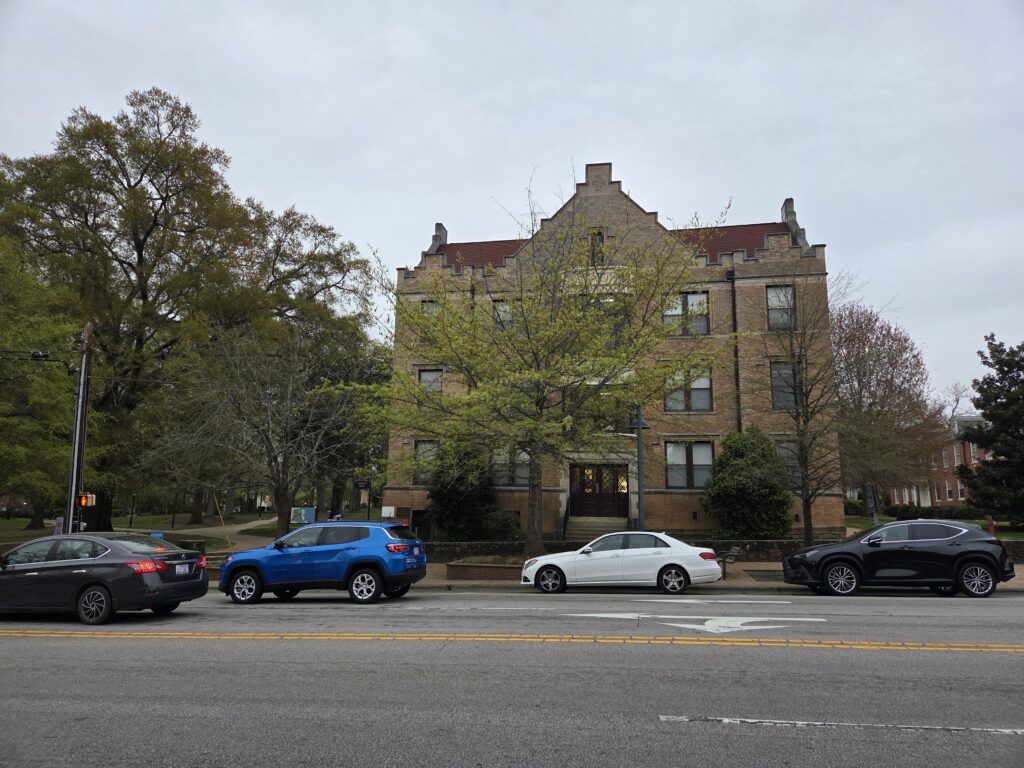
Another trio of oaks adorns the streetside end of Battle-Vance-Pettigrew Hall.
But I digress, we were talking about trees, yes, the trees. After the pistache (tree #13) we see as we approach Battle Hall, we come onto another trio of oaks, starting with the white oak (tree #14). This one gave me pause as it was quite late in breaking dormancy. Funny how trees of the same species, a few score feet apart in nearly identical conditions, can exhibit different behaviors. Likely the two white oaks came from two different populations and are expressing themselves in their own way. Everyone has an accent, right?
Next to this lovely oak is another laurel oak (tree #15), so similar to the willow oaks, it’s giving me pause even now as I put the name on the page (and again as I go through the rewrite a couple of weeks later…is this a willow oak? Good thing for me there’s not a quiz at the end of this). And third up is another pin oak (tree #16). There must’ve been a sale.
Last up on our little stroll east, we come to the Henderson Street intersection. One more tree at the light, another pistache (tree #17). A tree I’m sure you all will handily recognize by now, I’ll omit the picture. Keep a sharp eye for the amazing fall color later this year.
I would be remiss if I did not advise y’all in the nicest way to take a few minutes next time you find yourselves on this side of the street to continue on past this line of trees and hang a right turn onto campus. The quadrangle you enter is McCorkle Place and it can be a genuine pleasure to crisscross the space, especially early in the morning when the light is just so, or near dusk, before the lamps illume. Topic for a later article…
Many thanks for taking this short stroll with me along our downtown corridor. The trees are as much a part of the fabric of the space as the buildings, the lights, the traffic and the people. I hope you take a moment to recognize each of those next time you pass through. I doubt a building will appreciate a smile, a connecting touch or a kind word, but I like to think the trees do.
All photos by Geoffrey Neal.
Geoffrey Neal is the director of the Cullowhee Native Plant Conference. You can see more of his photography at @soapyair and @gffry. Margot Lester is a certified interpretive naturalist and a writer and editor at The Word Factory.
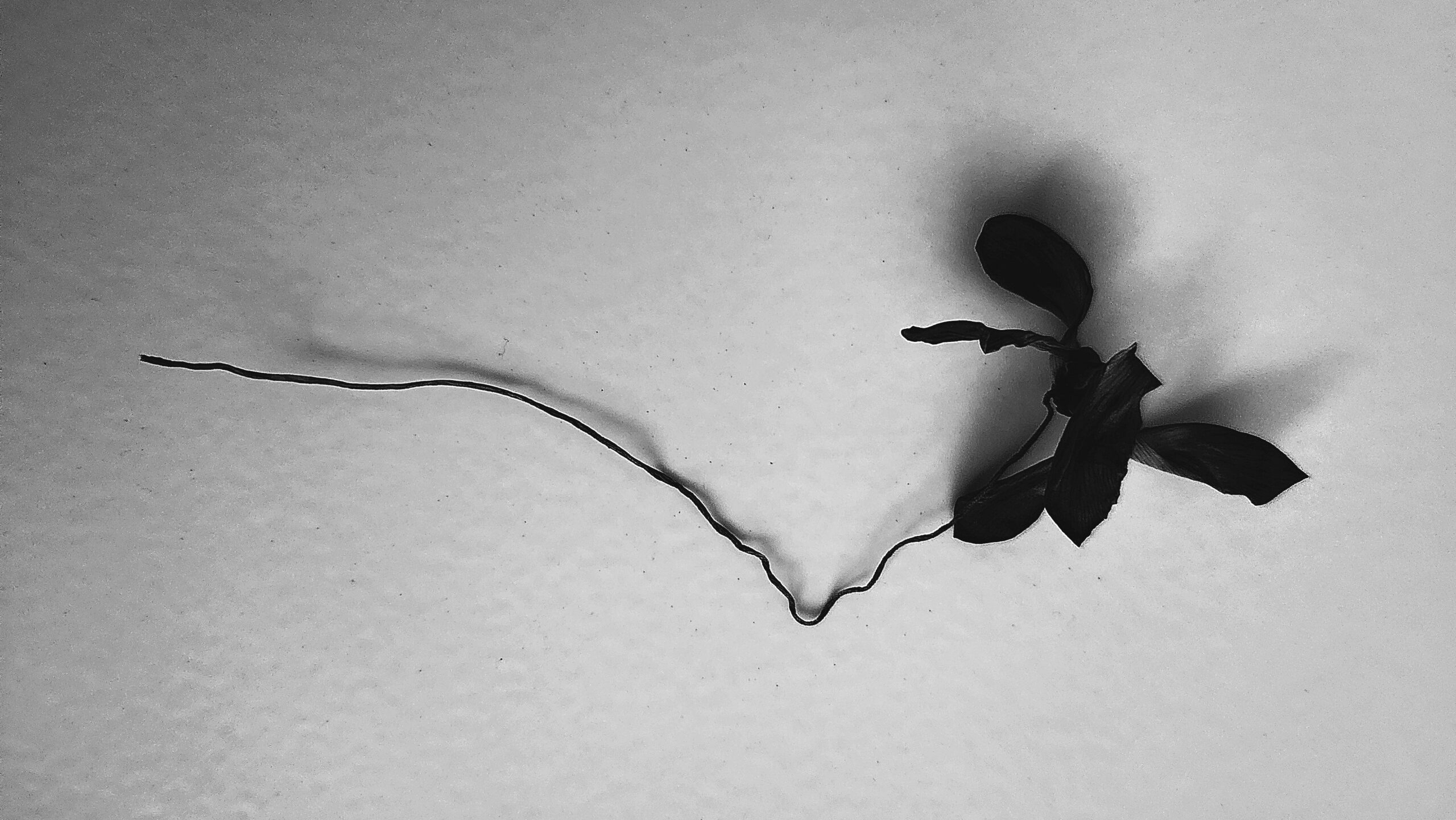
About the name: A refugium (ri-fyü-jē-em) is a safe space, a place to shelter, and – more formally – an area in which a population of organisms can survive through a period of unfavorable conditions or crisis. We intend this column to inspire you to seek inspiration and refuge in nature, particularly at the Arboretum!

